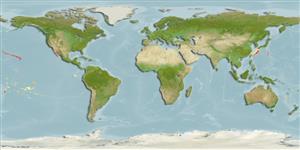>
Eupercaria/misc (Various families in series Eupercaria) >
Priacanthidae (Bigeyes or catalufas)
Etymology: Priacanthus: Greek, prion = saw + Greek, akantha = thorn (Ref. 45335).
Eponymy: Seth Eugene Meek (1859–1914) was an ichthyologist at the Field Museum of Natural History in Chicago. [...] (Ref. 128868), visit book page.
Environment: milieu / climate zone / depth range / distribution range
Ecologia
marinhas associadas(os) a recifes; não migratória; intervalo de profundidade 3 - 230 m (Ref. 38732). Tropical
Eastern Pacific: Hawaiian and Midway Islands; a single juvenile specimen recorded from the Galapagos Islands. Strays reach Johnston Atoll (Ref. 9710). Reports from Japan are probably misidentifications of Priacanthus hamrur.
Tamanho / Peso / Idade
Maturity: Lm ? range ? - ? cm
Max length : 33.0 cm TL macho/indeterminado; (Ref. 9710)
Inhabit clear lagoon and seaward reefs. Found under ledges during the day (Ref. 9710). Benthopelagic (Ref. 58302). Spawning may occur by December or soon after. Sound production has been studied in this species (Ref. 5403).
Ciclo de vida ou comportamento de acasalamento
Maturidade | Reprodução | Desova | Ovos | Fecundidade | Larvas
Starnes, W.C., 1988. Revision, phylogeny and biogeographic comments on the circumtropical marine percoid fish family Priacanthidae. Bull. Mar. Sci. 43(2):117-203. (Ref. 5403)
Status na Lista Vermelha da UICN (Ref. 130435: Version 2024-1)
Ameaça para os humanos
Harmless
Uso pelos humanos
Pescarias: pesca de subsistência; Aquário: Espécies comerciais
Ferramentas
Relatórios especiais
Baixar XML
Fontes da internet
Estimates based on models
Preferred temperature (Ref.
123201): 18.7 - 23.1, mean 20.8 °C (based on 10 cells).
Índice de diversidade filogenética (Ref.
82804): PD
50 = 0.5002 [Uniqueness, from 0.5 = low to 2.0 = high].
Bayesian length-weight: a=0.01698 (0.00734 - 0.03932), b=2.91 (2.72 - 3.10), in cm total length, based on LWR estimates for this (Sub)family-body shape (Ref.
93245).
Nível Trófico (Ref.
69278): 4.2 ±0.73 se; based on food items.
Resiliência (Ref.
120179): Elevada, tempo mínimo de duplicação da população menor que 15 meses (Preliminary K or Fecundity.).
Fishing Vulnerability (Ref.
59153): Low vulnerability (23 of 100).
Nutrients (Ref.
124155): Calcium = 53.3 [34.5, 83.5] mg/100g; Iron = 0.729 [0.464, 1.097] mg/100g; Protein = 19.3 [18.2, 20.2] %; Omega3 = 0.185 [0.121, 0.280] g/100g; Selenium = 43.7 [26.0, 76.3] μg/100g; VitaminA = 105 [45, 255] μg/100g; Zinc = 0.942 [0.676, 1.292] mg/100g (wet weight);
